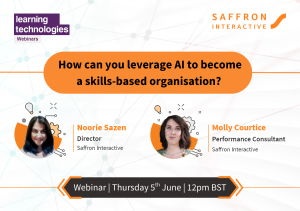There’s been a deluge of prediction lists recently, as there always is at this time of the year. ‘Learning trends 2019’… ‘What’s hot in L&D this year?’… ’17 unbelievable learning predictions, number 8 will blow your socks off!’
It’s always the same. Take a moment to look back at a couple of last year’s lists. They look almost identical, just spun slightly differently by marketing teams (sorry) and influencers. Yes, that might just reflect the snail’s pace this industry can move at, but it’s also a sign that we’re looking in the wrong places.
Consultants are always saying that learning teams need to integrate more closely with the business. That’s true. Except that most business people are also quite flummoxed about how to deal with digital disruption, so shouldn’t L&D be actually setting the agenda? Isn’t that the best way to be adding value?
“And how do we do that?” some of you may well be asking. The answer really comes from building skills capability. Soft skills will become essential skills in the world of digital disruption.
How you identify skills deficits and deliver skills capability is then something for you to consider. And real results don’t come from the latest fancy baubles. Don’t get me wrong, technological progression is an important part of improving the way we learn and work. It’s just that what matters more is how we really connect with learners on a deeper level.
The trends we should be understanding are the wider ones in the business world and the world in general. Trends that affect every one of us as consumers. By understanding how these affect the way we live and learn generally, we can design learning that fits into people’s lives, not just looks good on a progress review.
The fourth revolution
We’re at a bit of a tipping point. The world’s resources are being depleted as fast as the new digital frontier is being cluttered with endless data. That data feeds the algorithms that claw at our attention from every side, and our learning is just one of an endless stream of notifications jostling for attention.
You may have heard the soundbite that humans now have a shorter attention span than goldfish. An arbitrary claim, and perhaps a little harsh on poor goldfish, who actually have a rather good memory and are often used as ‘a model system for studying the process of learning and the process of memory formation, exactly because they have a memory and because they learn. ’ But it is an indicator of how easily we can be distracted.
People are disconnecting from the digital deluge, deleting their Facebook accounts and unsubscribing from email lists as the attention overload becomes just too much. The Center for Humane Technology (ex-Silicon Valley tech orchestrators), for example, warned of the dangers of social networks and smartphones ‘hijacking our minds and society’.
There’s no use just cranking out endless courses, or even resources, that will sit sadly in a forgotten corner of a forgotten LMS. We need to re-focus our attention on providing quality over quantity. That means supporting the learner to either free up their time by making their everyday tasks quicker and more productive or letting them learn, from scratch, in the moment of need using performance support tools.
It’s all about adding value. To the learner, and consequentially to the organisation.
Data was the new oil
We’re well past the initial goldrush of data being given out at will. GDPR and the endless privacy pop-ups, Cambridge Analytica and election fraud… modern consumers are now much savvier about where their data’s going, and what they get out of giving it away. They’re more aware of the potential of using their own data, too.
In fact, 75% of respondents to an IBM survey stated that they will not buy a product from a company – no matter how great the products are – if they don’t trust the company to protect their data.
Will learners start to apply the same to learning? After all, it is essentially an internal product that’s sold to teams. No matter how great the product, learners may start to think twice about whether they are being judged on their learning skills and performance; especially since most platforms don’t let the learner get any meaningful insights out of it. Will they question whether the course they’re being asked to do is as much about assessing them as it is helping them improve?
Thinking beyond mandatory compliance courses, will we need to provide a compelling reason for learners to hand over their behavioural data?
That requires creating real value from quality, personalised learning and ensuring transparency as to how exactly we’ll use their data. And we should use it only sparingly, taking what we really need and avoiding stockpiling vast amounts of data for its own sake… or worse still, selling it. Yes, metrics are vitally important, but we only need the right ones.

Circular learning
Sustainability is on the forefront of everyone’s mind as the limits to the planet’s resources have become abundantly clear (well, at least to most of us… President Trump has some way to go). Almost all large organisations are recognising the value of corporate social responsibility in a switched-on age from a consumer standpoint, and are demonstrating their awareness and action through marketing campaigns and initiatives.
Recycling by design is becoming a thing, and we should make the learning resources we create reusable as well. Modern work requires continuous lifelong learning, and we should aspire to create systems and processes that aid learners in this journey.
The circular economy is all about re-using and recycling, and we could take some learning lessons from that approach. Let’s stop pumping out single-use courses that are completed in one sitting, the equivalent of black plastic, and instead provide long-lasting learning that people can come back to again and again. Learning that supports them in their workflow and can be adapted over time; but which users can embellish with updated content, practical examples and tips.
The increasing awareness of social responsibility should also shine through in the content of our learning. Diversity, accessibility, and inclusivity should all be considered. We don’t need to target learning at obsolete idealised demographics. Everyone’s sick and tired of hearing about millennials, right?
Marketing learning
I’ve mentioned adding real value through our learning, but we also need to really communicate that value effectively. One theme I’ve seen running through a few of these prediction lists that I do agree with is the need for learning departments to pick up a thing or two from their marketing colleagues (yes, I’m biased).
That doesn’t necessarily mean big, bold, loud new initiatives. Remember, learners are already overloaded. In marketing, we often try to meet the customer where they are. That’s exactly what we need to do by better understanding learners’ points of view.
Everyone loves to hear from peers or the people that they admire the most in their company what the value of a course was for them personally. If learners can follow what peers are doing and what their leaders are learning; and can see engagement; then they are also more likely to wake up, take notice and act!
We marketers love a surveys too. That’s not something alien to L&D departments of course, but too many are focused on feel-good qualitative data collected long after the project is over. We need to collect actionable insights in real-time and not sit on that data, but instead let learners see that notice has been taken and that their opinion and engagement counts.
Conclusion
Unmoored in a barrage of notifications and awash in a sea of data, people are looking to understand how they connect to the world around them, how they’re relevant to it. People want to understand this in relation to the organisations they work for too, they want to feel relevant to their organisation, that they’re producing meaningful work. That’s the kind of value our learning should add. And that’s how it can add value back to the organisation itself.
Trends aren’t a bad thing. Progress certainly isn’t, but we need to focus on the deeper societal currents our learning can harness to provide not just business value, but real value to the people that power that business.
Want to know how to build a learning strategy that survives in the age of digital disruption? Download our Digital Disruption Survival Kit!





